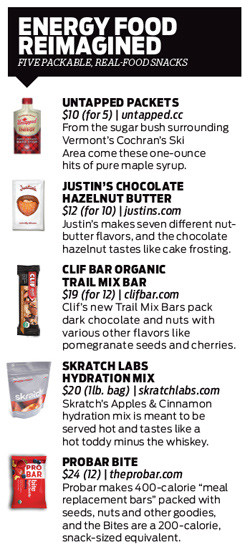As a committed cyclist who logs a few thousand miles annually, I can get way too focused on nutrition. Throughout the summer, my pantry is overflowing with energy gels, powders and protein bars to fuel and hydrate for—and recover from—big endurance efforts. Come winter, however, all that meticulous planning and those gel snacks get pushed aside—trail food is whatever is in the cabinet and recovery drinks are either hopped or malty. But which approach is better? And can I really earn another lap up the skintrack with energy gels and hydration mixes?
THE SCIENCE
“Things change in the winter and the cold changes how we keep hydrated and fueled,” says Dr. Allen Lim, a sports physiologist and founder of Skratch Labs, a maker of all-natural hydration mixes and energy foods. “We become a little less efficient, so we’re starting to lose some energy to try to stay warm.” According to Lim, while exercising under such conditions, a body reprioritizes its “substrate utilization”—i.e. what it burns first for energy—choosing carbohydrates over fat. Therefore, it’s important to keep carbohydrate stores high. “It’s a lot easier to do hard work in the wintertime,” Lim adds. “So if you’re really fit, you can burn potentially more calories in the wintertime than you do in the summertime. That being said, I always tell people that thirst and hunger still rule regardless of the environment.”
In terms of thirst and hydration, Lim notes that while sweat loss may be less during exercise in winter, water loss can remain high “because the temperature grade causes more of a vapor-pressure gradient for you to lose fluid through your lungs and through your breathing.” And while Lim notes that this water loss isn’t extremely significant, it can be amplified at altitude and over multi-day stretches.
 FOOD PLANNING
FOOD PLANNING
For nearly 40 years, Claudia Pearson has served as Rations Manager at the Lander, Wyo. Rocky Mountain branch of the National Outdoor Leadership School (NOLS), today planning for nearly 200 semester-long courses annually at 700 pounds of food apiece. Her approach comes down to four simple criteria: availability, cost, versatility and taste. “What we have always said here at NOLS is to eat a variety of food, eat throughout the day and hydrate often,” Pearson explains. While her food planning focuses on large-group, multi-day settings, her outlook—advocating for real food—is something easily transferrable to any sized outing. “We issue bacon, sausage, chicken fajita mix—it’s all about calories that are easy to prepare,” Pearson says. “It’s quick, one-pot type meals that get the most number of calories into the smallest thing.”
PACK IT IN
“I make sure everything is packed in a way that I will be able to manage at 20˚ below with high winds,” says Marshall Thomson, an elite endurance runner, skimo athlete and winner of the Elk Mountains Grand Traverse. Thomson avoids Ziploc bags that can be hard to open with frozen fingers—opting instead for tinfoil and even Tupperware—and foods that can freeze, like certain gels. “I’m also not eating huge amounts at once—these are packable, two-to-three-bite portions I carry,” he says. “In the end, it’s all about what will taste good and keep my body happy.”
TO YOUR HEALTH
So what about energy gels versus that leftover baked ziti? “There’s so much marketing out there that says that prepackaged foods are better for you that there is a bit of a placebo effect,” says Lim. And while Thomson utilized gels like Gu Roctane when racing, he prefers the real stuff when tours get rugged.
“I feel like if you are having a rough time and bonking, real food helps you snap out of it more than eating a gel or bar,” he says. “During my first Grand Traverse, a guy started pulling out slices of pizza and gave me one. It was one of those times that I was bonking and the pizza saved my day.”
—
This story first appeared in the November 2015 issue.











Got to agree with Marshall, I find that these dedicated foodstuffs are only as effective as you decide they’re going to be. I like to eat real, and eat well.
Pearson makes an excellent point about getting the most calories in the quickest, smallest way possible. A trend that has grown and is likely to ocntinue over time.